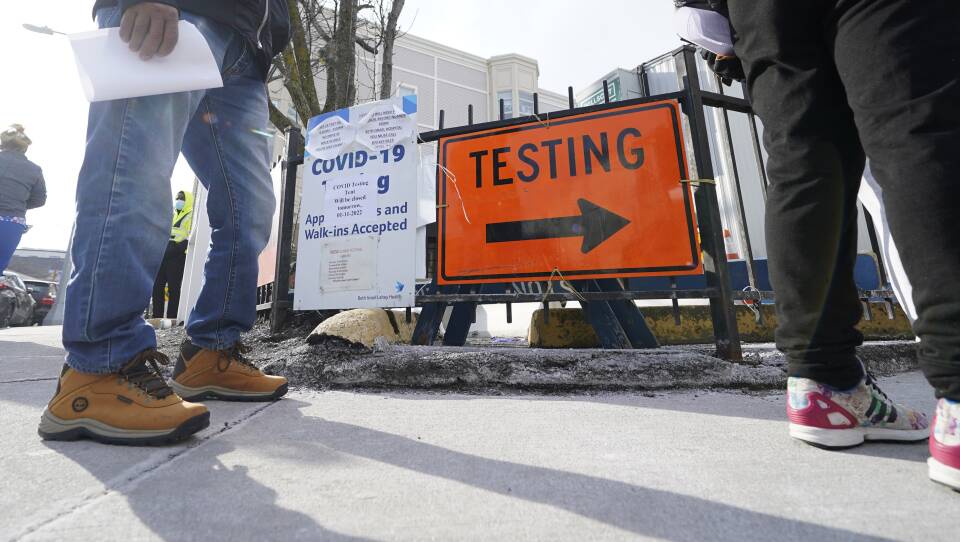Looking at the level of coronavirus detected in wastewater has become the leading indicator over testing of determining if cases are rising or falling. Many people have seen the latest line graph showing that in the Boston area, the surge has passed . Joseph Allen, associate professor at the Harvard T.H. Chan School of Public Health and director of the Healthy Buildings Program, joined hosts Paris Alston and Jeremy Siegel on Morning Edition to decipher the data. This interview has been edited for clarity and length.
Jeremy Siegel: So looking at these graphs put out by Biobot, the company in Cambridge that's been testing wastewater levels in the area, we are near or at basically the same level as we were at in August through about November of last year. Entering our third year at this point of the pandemic, what patterns are you seeing emerging?
Joseph Allen: The wastewater monitoring data has become one of our best leading, unbiased indicators of where we are. And if you look at the plots that are produced, you can actually see that clearly we're on the back end of the omicron surge. But not only that, as you said, it tells us we're kind of seeing the levels we saw all the way back to last August and importantly, we didn't see a plateau. Last year after the surge in January, February, we had kind of a plateau in March when the Alpha variant hit. And so far, the good news is we haven't seen a plateau. In fact, it's starting to be below the levels we saw last August right now. So all signs are looking good.
Siegel: How different is what we're seeing right now compared to these points last year?
Allen: Well, just in terms of the wastewater, first, we should recognize that the levels of omicron were extraordinarily high. So while we're on the back end of the surge, the peak was massive compared to last year, even through the alpha and delta surges. So that's really quite different. We've seen this around the world, but when omicron hits, it hits fast and furious, but also drops fast and furious, which is a good thing.
And yes, this is not like March 2020 in a lot of ways. We have a safe and effective vaccine. We've been rolling out boosters. The Biden administration has been getting approval of more rapid test platforms. We have new therapeutics coming out on the market. They've delivered high grade masks and have ramped up that delivery and access. So for a lot of reasons, we're in a much different place and on top of the high vaccination of booster rates that vary widely across the country, we also have an immune wall building. We've had massive infection across this country during this omicron surge, and all of that is contributing to this sharp decline that we're seeing in New England, but also starting to see in other parts of the country.
Paris Alston: Joseph, you've discussed and written about how wastewater remains one of the best unbiased and leading indicators of how much virus we are seeing. And that's because it's not influenced by the amount of testing that's being done or who's doing the testing. Do you see us using this in the future for other types of health tracking?
Allen: Absolutely. There's a lot more we can detect in the wastewater. I think Biobot has been a terrific company here and leading some of their COVID based work, but also they can detect a lot more. So yes, I think it's a tool we've been underutilizing in some parts of the country, and I'm optimistic.
And why is it unbiased? Think about the rise in rapid tests, with 400 million plus rapid tests on the market at least, and they don't get captured in any formal accounting, right? So who gets testing, who has access to tests and who can afford testing, who takes a positive test, doesn't report it, who is negative on a rapid test doesn't get counted in the denominator. So there are a whole bunch of ways these metrics we've been using for the first two years, maybe were good in the first year, but really going to become less important or less valuable and more biased as time goes on where as wastewater is not.
Boston wastewater thru 2/14 (🧵)
— Joseph Allen (@j_g_allen) February 16, 2022
-same data plotted on log scale by @NorthShoreMAwx
-much easier to see that we are at/below Aug-Nov levels
-also reveals the extended plateaus (like last year's 'alpha plateau' in Mar-April, and this fall), and the spring/summer reprieves pic.twitter.com/SKOA49WuQ0
Alston: I want to talk about masks for a second because when we were gearing up to go back to school in September, masks were a given back then. But now we're at a similar level of cases. Yet the governor has lifted the mask mandate in schools. We're seeing several cities and towns across the Commonwealth starting to lift their mask mandates. And we're also seeing the state issuing guidance that people who are fully vaccinated no longer have to wear masks indoors. Is that the right direction?
Allen: Yeah, I think it is. This has gotten unnecessarily contentious, but if you look across experts, most experts are saying, yes, it's time to pull back when things look good. And I think the difference here honestly are a matter of a couple of weeks. Some people think the next week or two. Some people think right now, and some people think mid-March, end of March. But really, we're talking about a pretty small window here. And it reflects the reality that we talked about how we're in a different spot than two years ago with vaccines, boosters.
We have the tools to keep everyone safe. I want to be clear, it doesn't mean the pandemic is over. It simply means we should take advantage of this lull, the reprieve post-omicron surge and go back to doing the things we need to do for pandemic preparedness in case we get another curveball from this virus, which is likely.
"When omicron hits, it hits fast and furious, but also drops fast and furious, which is a good thing."-Joseph Allen
Siegel: Do you think that's going to be the trend in public health policy, that we essentially ride these coronavirus waves and make these calls sort of on a dime based on where cases are at a given point? That we might see mask mandates and then they'll be dropped and then they'll come back and then they'll be dropped and then they'll come back.
Allen: I think that's likely, and I think it will vary by region. We've seen some parts of the country haven't really had mask mandates and others have. But yes, I think that makes a lot of sense. First we have to see if there's another major curveball like a variant that escapes immune response and then it's a whole new ball game.
But if it keeps going the way it's going right now where we have periodic surges, then I think it makes sense to push back on some of these controls. Also, we're reaching the point again where people have the tools. You should be vaccinated, you should be boosted. And on top of that, you can wear a high-grade mask. So if that risk doesn't feel low enough for you, even if mask mandates go away. You can still wear a high-grade mask and be protected.









